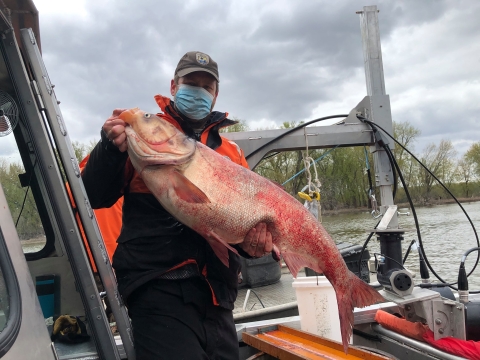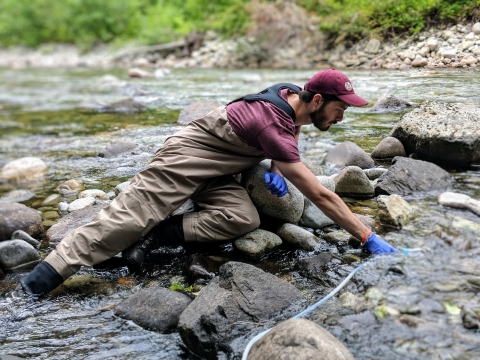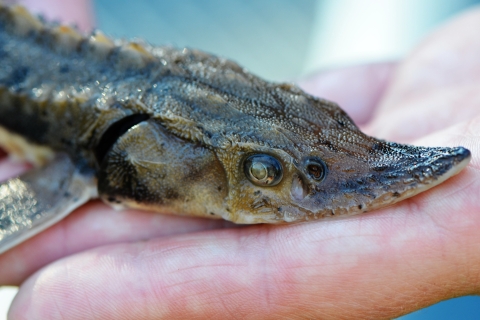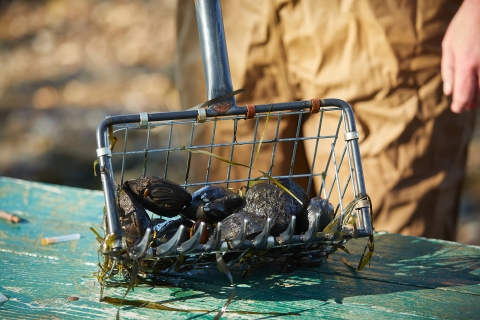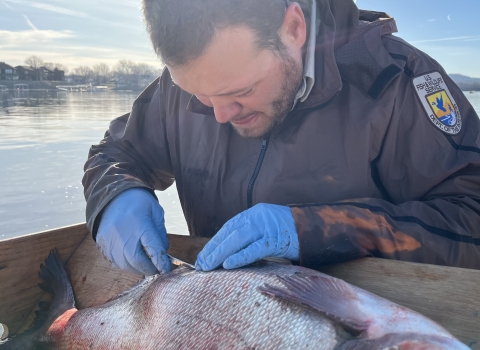What We Do
Invasive Carp Projects
Telemetry
We maintain an acoustic telemetry array in the Upper Mississippi River from Pools 5 to 20. This is part of a larger multi-agency array that extends from Minnesota to Missouri and includes portions of the Illinois and Ohio Rivers. Bighead and silver carp are tagged with trackable acoustic tags and their movements can be traced up and down the river system using this array. This allows biologist to analyze their movement patterns and pool-pool transitions. This information can then be useful in directing invasive carp removal efforts and advising the placement of potential invasive carp deterrents.
Split-beam hydroacoustics
This technology uses sound waves to detect underwater fish targets and allows biologists to analyze the density and size structure structure
Something temporarily or permanently constructed, built, or placed; and constructed of natural or manufactured parts including, but not limited to, a building, shed, cabin, porch, bridge, walkway, stair steps, sign, landing, platform, dock, rack, fence, telecommunication device, antennae, fish cleaning table, satellite dish/mount, or well head.
Learn more about structure of fish communities over a large area. Coupled with fish capture data, biologists hope to use hydroacoustics in the Upper Mississippi River to determine relative abundances and size structure of the invasive carp population in specific areas.
Multi-beam sonar
Adaptive Resolution Imaging Sonar, which is a multi-beam sonar camera, is used to capture video-like underwater images. Biologists use this technology to monitor fish behavior, particularly in response to deterrents, such as underwater speakers or electric barriers, to help determine the effectiveness of such deterrents.
eDNA
Environmental DNA, or eDNA, is species-specific DNA material from an organism that is shed or excreted into the environment. In the Upper Mississippi River and the Chicago Area Waterway System eDNA sampling is used in addition to other methods to monitor and detect emerging invasive carp populations. La Crosse Fish and Wildlife Conservation Office collects and preserves eDNA water samples in the field. The samples are then genetically processed by the Whitney Genetics Lab.
Native Species Projects
We work to help survey native fish and mussel populations in support of the U.S. Fish and Wildlife Service’s tribal trust responsibilities and federal fish hatcheries.
Lake Sturgeon Restoration
We work with several Native American tribes to support lake sturgeon restoration in ceded territory lakes. With the collaboration of the White Earth Nation and Red Lake Nation in Minnesota, the Rainy River First Nation in Canada, the Minnesota Department of Natural Resources and Genoa National Fish Hatchery, we work to restore lake sturgeon populations in northwestern Minnesota, including Round Lake, White Earth Lake and Red Lake. Genoa National Fish Hatchery is responsible for hatching eggs collected from adult sturgeon in the Rainy River and rearing the sturgeon to fingerling size and stocking them into these lakes. Staff annually assist in this effort by tagging sturgeon prior to stocking and monitoring their growth and survival.
Walleye Population Assessment
We assist the Great Lakes Indian Fish and Wildlife Commission with walleye population assessments on ceded territory lakes in Minnesota and Wisconsin. Each spring, staff along with tribal and state partners, conduct night electrofishing in target lakes to assess walleye populations which helps to inform annual harvest quotas.
Freshwater Mussel Survey Assistance
We assist with the annual survey and collection of freshwater mussels in the Upper Mississippi River basin including the Higgins’ eye pearlymussel and winged mapleleaf. Both of these species are federally endangered. Staff pollywog, or snorkel in shallow water, and prove diver support to assist in surveys lead by malacologists from the Genoa National Fish Hatchery.
Wild Fish Health Surveys
Fish diseases are detrimental not only to fish but also to humans and the entire ecosystem. Fish disease and pathogens affect us economically and ecologically. Wild fish are often used at fish hatcheries and it is important to biologists to know that they have disease-free brood stock. Staff capture wild fish in the Upper Mississippi River Basin in support of pathogen testing. This involves annual electrofishing surveys where various fish species are collected from target areas and fish tissue samples are obtained and analyzed by the La Crosse Fish Health Center.
Habitat Programs
Our habitat biologists work with federal, state, non-profit and community partners to design and implement numerous projects related to priority species and habitat conservation.
National Fish Passage Program
The Habitat Branch of the La Crosse Fish and Wildlife Conservation Office works with state natural resource agencies, county and local organizations and government, tribal communities, non-governmental organizations, and others to restore passage for native fish, mussels, and other aquatic organisms, improve natural river and stream flows, sediment transport, and reconnect needed habitats that have been fragmented by dams, culverts, and low water road crossings. The office habitat branch works with partners to address barriers that fall within the Upper Mississippi River basin of Minnesota, Iowa and Wisconsin and the Red River of the North basin in northwestern Minnesota. Our efforts are focused on Lake Sturgeon, Topeka shiner, federally listed and state species of greatest conservation need mussels. Below features a dam removal on Buffalo Creek (right: stage 1, center: stage 2, left: complete).
National Fish Habitat Partnership
As part of the National Fish Habitat Partnership, our habitat biologists coordinate conservation projects in Minnesota, Wisconsin, Iowa, Illinois and Missouri. The mission of this national partnership is to “protect, restore and enhance the nation’s fish and aquatic communities through partnerships that foster fish habitat conservation and improve the quality of life for the American people.” These biologists are heavily involved in two regional partnerships within this national partnership: the Fishers and Farmers Partnership and the Driftless Area Restoration Effort.
Fishers and Farmers Partnership
The Fishers and Farmers Partnership of the Upper Mississippi River Basin is a self-directed group of nongovernmental agricultural and conservation organizations, tribal organizations and state and federal agencies working to achieve the partnership's mission to “support locally-led projects that add value to farms while restoring aquatic habitat and native fish populations." This partnership is coordinated by a biologist at the La Crosse Fish and Wildlife Conservation Office. Activities of the partnership are based on three fundamental principles: finding common ground for sustaining agriculture and fishes together; promoting local leadership and providing flexible assistance of conservation projects; and collaborating and learning to achieve measurable results at the basin scale. For example, one of the current projects aims to restore oxbow lakes to create habitat for the endangered Topeka Shiner and return their presence to historic ranges.
If you're interested in participating in this program, please contact the program coordinator: Heidi Keuler
Driftless Area Restoration Effort
The La Crosse FWCO is the Fish and Wildlife Service representative for the Driftless Area Restoration Effort (DARE), a fish habitat partnership that participates in the National Fish Habitat Partnership Program. The Driftless Area is a naturally defined geographic region full of rivers and streams that contain diverse assemblages of fish, mussels, amphibians, reptiles, and aquatic invertebrates. The partnership coordinated by Trout Unlimited was formed in late fall 2005 to jointly address the issues of habitat degradation, loss, and alteration of cold-water streams, and cool and warm-water rivers. Regional partners agreed there was an elevated need for coordinated management and protection of aquatic resources throughout the Driftless Area. The La Crosse FWCO works with Trout Unlimited and Driftless Area partners on restoration projects, assessments, GIS projects and other partnership support needs.
If you're interested in participating in this program, please contact the program coordinator: Louise Mauldin
Our Projects and Research
Understanding seasonal movements and habitat preferences of invasive species is one key to controlling them. If you want to control an invasive species, you must know where they are. To control them efficiently, you need data on their hotspots, where they live during different times of the year, and when they are most active during the day. Acoustic telemetry is one way that biologists are...
It's one of the state's most popular rivers for canoeing, kayaking, tubing, and fishing.
The Upper Iowa River offers the most public land access of all Iowa Rivers.
The Scenic River and Water Trail meanders through limestone bluffs and driftless trout streams and draws visitors from all over the country....



